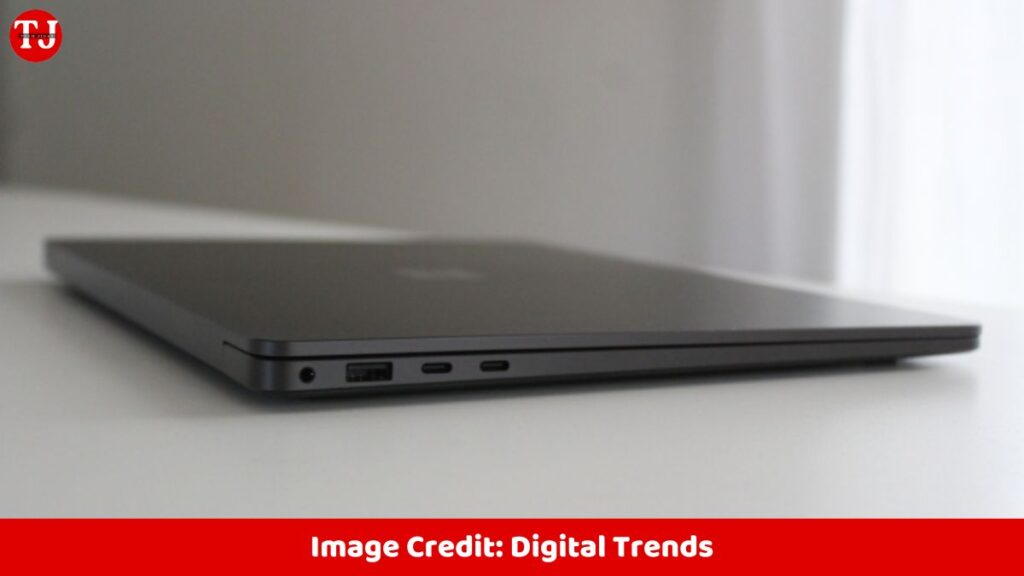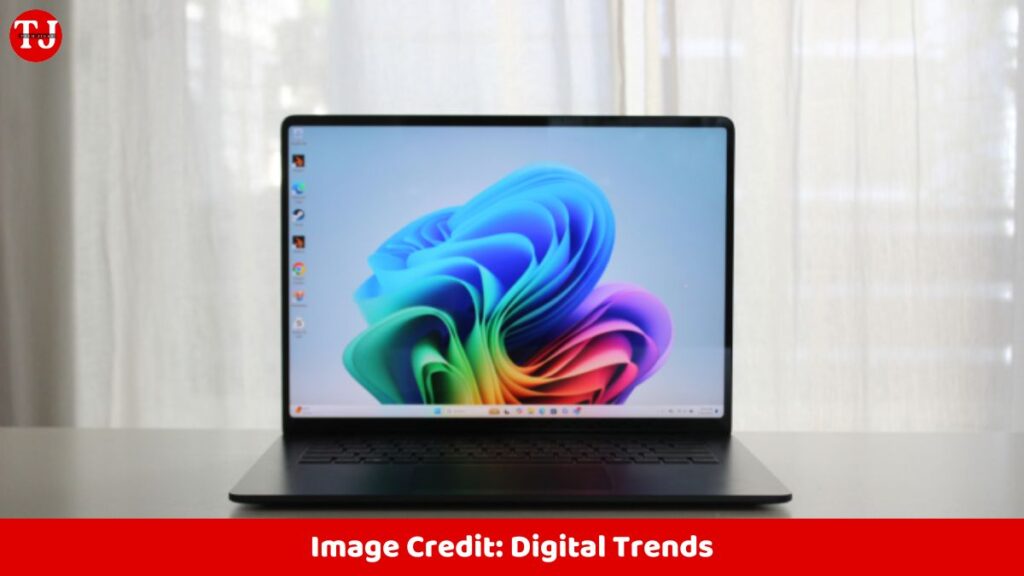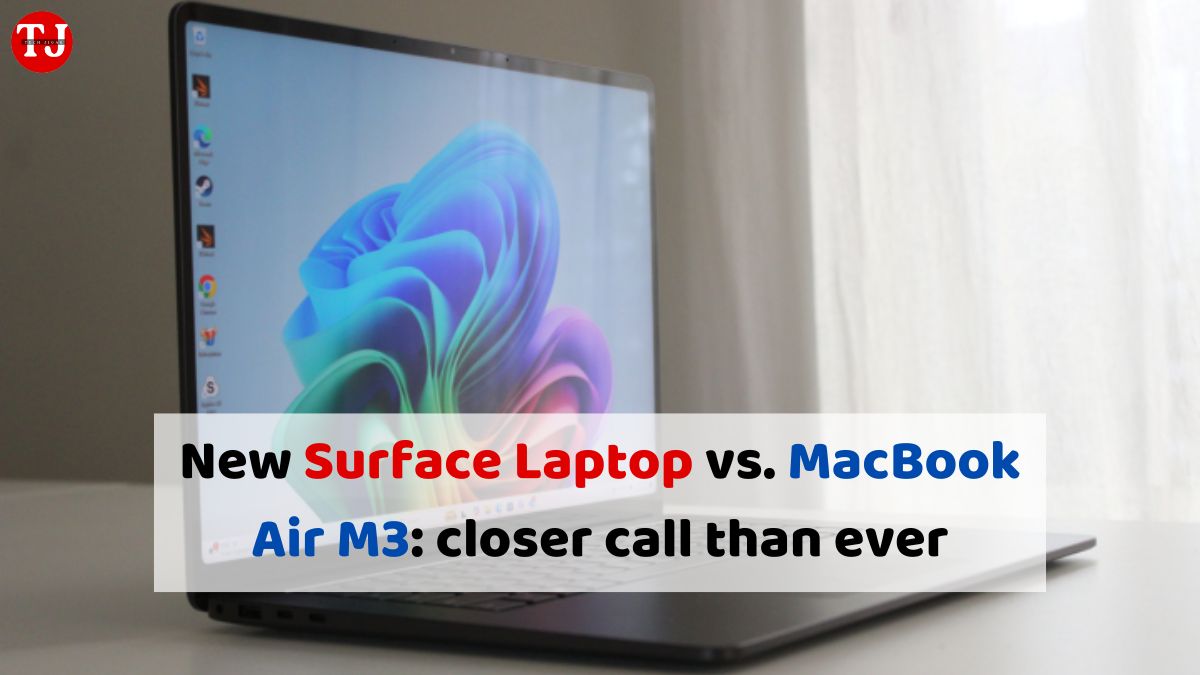The Surface Laptop was designed to be a strong competitor to the MacBook Air, boasting a sleek design and strong branding. However, it has often fallen short in performance and battery life, preventing it from fully matching its rival.
With the transition to Qualcomm’s Snapdragon X chips and the integration of Copilot+, the Surface Laptop 7th Edition brings renewed optimism for surpassing the MacBook Air M3. After spending time with the device, I’m genuinely convinced that it might be the best Surface device ever made, offering impressive performance and features that could set a new standard in the market.
Specs and configurations
| Microsoft Surface Laptop 7th Edition | Apple MacBook Air M3 | |
| Dimensions | 13.8-inch: 11.85 x 8.67 x 0.69 inches 15-inch: 12.96 x 9.41 x 0.72 inches | 13-inch: 11.97 inches x 8.46 inches x 0.44 inches 15-inch: 13.40 inches x 9.35 inches x 0.45 inches |
| Weight | 13.8-inch: 2.96 pounds 15-inch: 3.67 pounds | 13-inch: 2.70 pounds 15-inch: 3.3 pounds |
| Processor | Qualcomm Snapdragon X Plus (10-core) (13.8-inch only) Qualcomm Snapdragon X Elite (12-core) | Apple M3 (10-core) |
| Graphics | Qualcomm Adreno | Apple M3 (8-core) Apple M3 (10-core) |
| RAM | 16GB 32GB | 8GB 16GB 24GB |
| Display | 13.8-inch 3:2 2304 x 1536 IPS, 120Hz 15.0-inch 3:2 2496 x 1664 IPS, 120Hz | 13.6-inch 2560 x 1664 IPS, 60Hz 15.3-inch 2880 x 1864 IPS, 60Hz |
| Storage | 256GB SSD 512GB SSD 1TB SSD | 256GB 512GB 1TB 2TB |
| Touch | Yes | No |
| Ports | 2 x USB4 with Thundrebolt 4 1 x USB-A 3.1 1 x 3.5mm audio jack 1 x Surface Connect | 2 x USB-C with Thunderbolt 4 1 x 3.5mm audio jack 1 x MagSafe 3 |
| Wireless | Wi-Fi 7 and Bluetooth 5.4 | Wi-Fi 6E and Bluetooth 5.3 |
| Webcam | 1080p with infrared camera for Windows 11 Hello | 1080p |
| Operating system | Windows 11 | macOS Sonoma |
| Battery | 13.8-inch: 54 watt-hour 15-inch: 55 watt-hour | 13-inch: 52.6 watt-hour 15-inch: 66.5 watt-hour |
| Price | $999+ | $1,099+ |
| Rating | 4.5 out of 5 stars | 4 out of 5 stars |
Both the Surface Laptop and the MacBook Air offer 13-inch and 15-inch models, catering to different user preferences. The 13.8-inch Surface Laptop starts at $999 and features a Qualcomm Snapdragon X Plus chipset, 16GB of RAM, and a 256GB SSD. In comparison, the M3 MacBook Air starts at $1,099 but includes only 8GB of RAM. To match the Surface Laptop’s 16GB of RAM and 256GB of storage, the MacBook Air costs $1,299. This upgrade also includes two additional GPU cores, enhancing its graphics performance.
Both companies charge an additional $200 to upgrade the storage to 512GB, or $400 to increase it to 1TB. Overall, the Surface Laptop is $200 less expensive than the MacBook Air. However, there’s a catch: Microsoft charges $200 to upgrade from the Snapdragon X Plus to the Snapdragon X Elite, making it still $100 cheaper than the MacBook Air.
Design

These laptops share several key features. Both are slim and lightweight, available in two different sizes that closely match in terms of dimensions. Each laptop boasts an attractive design and ranks among the best-built devices on the market today.
The latest Surface Laptop features thinner bezels, although they are not as slim as those on the MacBook Air. However, the Surface Laptop benefits from a notch-free design. Both laptops sport screens with rounded corners, but on the MacBook Air, only the top corners are rounded.
The Surface Laptop 13.8-inch model is fairly thin and light, measuring 0.69 inches in thickness and weighing 2.96 pounds. However, the MacBook Air 13 stands out with its impressive thinness at just 0.44 inches and a slightly lighter weight of 2.7 pounds. The MacBook Air 15 also impresses with a thickness of only 0.45 inches and a weight of 3.3 pounds. In comparison, the Surface Laptop 15 is 0.72 inches thick and weighs 3.67 pounds. Clearly, the MacBook Air models are significantly thinner and lighter.
The color options are another major difference between these two laptops. The MacBook Air is available in Silver, Starlight, Space Gray, and Midnight, offering a range of subtle and elegant choices. In contrast, the Surface Laptop 7th Edition comes in bolder colors: Sapphire, Platinum, Black, and Dune. Microsoft’s selection caters to those looking for more striking and vibrant options.
Keyboards and touchpads

The MacBook Air 13 features Apple’s renowned Magic Keyboard, widely regarded as one of the best keyboards available. It boasts large keycaps with ample spacing and light, responsive switches, making for a pleasant typing experience. On the other hand, the Surface Laptop 7th Edition’s keyboard has also been updated and offers a delightful typing experience. While both are excellent, the MacBook Air stands out with its larger keycaps, including those in the function row.
Both laptops now feature haptic touchpads, enhancing their user experience. The MacBook Air 13’s Force Touch touchpad remains excellent, offering extreme precision, responsiveness, and the Force Click feature for added functionality. Meanwhile, the Surface Laptop introduces a new, wider haptic touchpad. The 13.8-inch model’s touchpad is notably large, although the 15-inch model retains the same size, resulting in some unused space around the palm rests. In contrast, the 15-inch MacBook Air boasts a larger touchpad that better utilizes the available space.
Additionally, the Surface Laptop’s display is touch- and pen-enabled, a feature not available on the MacBook Air 13.
Connectivity, webcams, and security

The Surface Laptop features two versatile USB-C/USB4 ports, complemented by a USB-A 3.1 port and a convenient 3.5mm audio jack. For charging, it includes the Surface Connect port. Additionally, the 15-inch model includes a microSD card slot, adding further flexibility to its connectivity options.
The MacBook Air M3 features two USB-C/USB4 ports supporting Thunderbolt 3, along with a 3.5mm audio jack and MagSafe 3 for charging. This design reflects a modern approach, prioritizing newer technology over legacy support. It’s important to note that while the Surface Laptop can connect to three 4K external displays, the MacBook Air M3 supports one external display with its internal display active, and up to two displays when its lid is closed.
The Surface Laptop outshines the MacBook Air M3 in wireless connectivity, boasting support for Wi-Fi 7 and Bluetooth 5.4 compared to the MacBook Air’s Wi-Fi 6E and Bluetooth 5.3.
Both laptops feature a 1080p webcam, but the Surface Laptop enhances user experience with neural processing unit (NPU) support. This enables advanced AI features like Microsoft’s Studio Effects for background blurring, automatic framing, creative filters, and more. While both laptops leverage AI capabilities locally, the Surface Laptop’s more robust NPU gives it an edge, at least until the MacBook Air receives an update to the M4.
Moreover, the Surface Laptop includes an infrared camera for Windows 11 Hello facial recognition, whereas the MacBook Air M3 relies solely on a Touch ID fingerprint reader.
Performance

The latest Surface Laptop marks a significant upgrade by shifting from Intel to Qualcomm’s Snapdragon X chipsets. These new chipsets promise performance comparable to Apple’s MacBook Air, powered by Arm-based Apple Silicon M3 chipsets. Qualcomm offers two variants of the Snapdragon X: the 10-core Snapdragon X Plus and the 12-core Snapdragon X Elite. In leaked benchmarks, the Snapdragon X Elite shows superior performance in Geekbench 6, while the Snapdragon X Plus appears to deliver similar speeds.
The initial tests are promising, but we need formal benchmark testing of Qualcomm’s chipset to determine which is faster. Both laptops are expected to be very fast for productivity tasks, though performance in creative applications remains uncertain. The Snapdragon X chipset features the Qualcomm Adreno GPU, which may be slightly slower than the M3’s eight-core or 10-core GPU, but this has yet to be confirmed. It’s worth noting that the Surface Laptop has fans, whereas the MacBook Air is fanless. This design choice makes the MacBook quieter, but it might limit sustained performance compared to the Surface Laptop.
Both laptops are equipped with Neural Processing Units (NPUs), known as the Neural Engine in Apple’s terminology. Qualcomm boasts a performance of 45 trillion operations per second (TOPS) for its NPU, whereas Apple’s M3 chipset achieves 18 TOPS. If these figures are directly comparable, the Surface Laptop will deliver faster on-device AI performance until Apple releases a MacBook Air featuring the M4 chipset, which Apple claims will reach 38 TOPS.
Display and audio

The Surface Laptop comes in two display sizes: 13.8 inches and 15 inches, both featuring a 3:2 aspect ratio. The 13.8-inch model offers a resolution of 2304 by 1536, while the 15-inch model boasts a resolution of 2496 by 1664. Although these resolutions are slightly lower than the MacBook Air’s 13.6-inch (2560 by 1664) and 15.3-inch (2880 by 1864) displays, all screens are IPS panels. A significant advantage of the Surface Laptop displays is their 120Hz refresh rate, which provides smoother visuals compared to the MacBook Air’s 60Hz displays.
The Surface Laptop and MacBook Air offer nearly identical quality, with comparable color accuracy, contrast, and color saturation. However, the Surface Laptop stands out with its superior brightness, reaching a maximum of 561 nits compared to the MacBook Air’s 497 nits. While the MacBook Air boasts sharper visuals, the Surface Laptop excels in speed and brightness.
When it comes to audio quality, the MacBook Air holds a significant advantage. The 13-inch MacBook Air M3 features an impressive four-speaker audio system that surpasses most competitors. Meanwhile, the 15-inch version boasts a six-speaker setup with force-canceling woofers, matching the high standards of the more expensive MacBook Pro models. This makes it the best audio system available on laptops today. In comparison, the Surface Laptop is equipped with Omnisonic speakers that project sound through the keyboard. While this setup offers decent audio quality, it doesn’t reach the level of the MacBook Air.
Portability

Both laptops, available in 13-inch and 15-inch versions, offer excellent portability. However, the MacBook Air M3 stands out as the most portable of all, boasting a thinner design and being significantly lighter than the Surface Laptop.
Microsoft claims that their 13.8-inch Surface Laptop can provide up to 20 hours of local video playback and up to 13 hours of active web usage. The 15-inch version boasts even better battery life, with up to 22 hours of video playback and 15 hours of web usage. However, our tests show that the MacBook Air M3 13-inch achieved an impressive 19.5 hours of web browsing, making it significantly longer-lasting than the Surface Laptop for this activity.
Considering that the main advantage of Windows on ARM is extended battery life, our testing will be particularly insightful. There’s a strong possibility that the MacBook Air M3 will maintain its edge in efficiency, potentially offering substantially longer battery life compared to the Surface Laptop.
It’s as even as it’s ever been

The Surface Laptop has finally become a true competitor to the MacBook Air with its 7th Edition. After years of potential but falling short, this version brings significant improvements in performance, battery life, display, and trackpad. Not only is it more affordable than the MacBook Air, but it also offers greater upgradeability, allowing users to swap out the SSD as needed.
While the MacBook Air shines with superior battery life and a noticeably thinner design, making it an excellent choice for a highly portable device—especially the 13-inch model—it isn’t a clear winner in all aspects.
Personally, I favor the Surface Laptop for its extra screen real estate, thanks to its 3:2 aspect ratio. However, both the MacBook Air and the Surface Laptop are great options, and you can’t go wrong with either.
